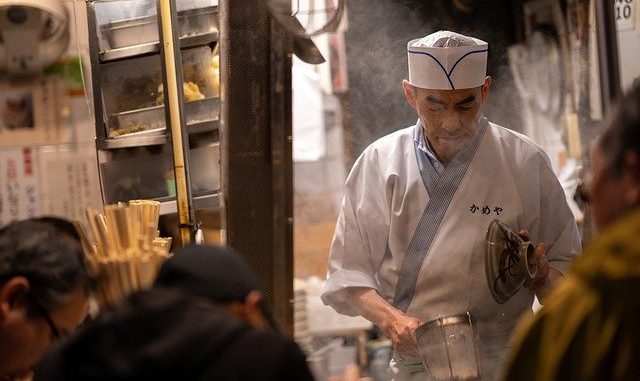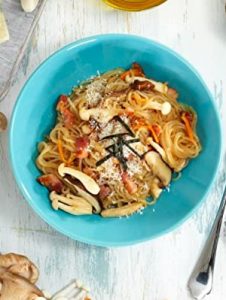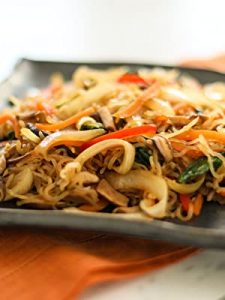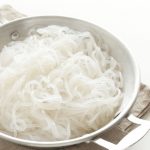
Shirataki noodles (白滝, usually written with the hiragana しらたき) are traditional Japanese noodles which have extremely valuable health benefits. They are prepared from konjac flour which is obtained from the tuber or yam of the konjac plant. They are sometimes listed as konjac noodles, konnyaku noodles and miracle noodles.
One of the main benefits is that noodles are almost zero calorie and zero carb (carbohydrate). This makes them ideal for keto diet products.
What Is Konjac ?
Konjac flour is rich in glucomannans which also makes the flour high in dietary fiber. All konjac based noodles are obtained from the tubers of various species of a plant known as Amophophallus.
Shirataki noodles come in various guises. There are wet and dry forms. The wet forms are usually packaged in sachets with water and a firming agent. The firming agents are usually a small amount of calcium hydroxide.
You can get straightforward udon noodles, but also spaghetti, linguine, fettucine or the really thin angel hair. The dry form could be used in noodle pots which are protected with an aluminium foil lid. There are also rice forms too and a variety which could be used for minestrone type soups.
Flavour
Some people think they have a strange fishy smell but this may be just anecdotal. It is associated with the yam flour. It is best to wash and drain these noodles a few times to get rid of this fishy smell. The noodles should have the water squeezed out of them too just to be certain. We have found that adding strongly flavoured vegetables and a Japanese style sauce base using soy works extremely well and helps to overcome any remaining lingering aroma.
The texture of these noodles can also be highly variable. For some, they are described as being like rubber bands no matter how they are cooked. Apart from rinsing them very well, it is best to pan-fry them without oil or any other liquid so the liquid is removed. Less water means better texture. Having said that, they are easier to eat once water is re-added as in a stir-fry for example.
In summary, the noodles maintain their structure well in boiling water. The best way to cook them is to dry roast them after they have been drained properly. It also makes sense to cook them in a stock which also helps dispel the strange flavour notes they first have.
The noodles are often served in Japan in a cast-iron pot called a donabe.
Nutritional Value
These noodles are noted for having very few carbohydrates but not only that, rich in fiber if you assume that the carbohydrate content is low. The fiber content is actually 3 per cent by weight because most of these noodles are 97% water. The fiber content is 1.4 grams/100g wet weight of noodles.
They are also gluten and lactose free. If only the noodles are needed then a claim of fat-free is possible because fat content is negligible. These claims are ideal as a health food. It is also ideal as a vegan foodstuff or for anyone on a keto, low-carb or gluten-free diet. A 100g serving of noodles is just 4 kcals with 1 gram approximately of net carbs. There are no sugars.
The noodles are especially popular in both Japanese and Chinese cuisine.
Variants Of Konjac or Shirataki Noodles
Shirataki noodles usually come in their natural flavour but there are other variants. We have tried types containing oats, seaweed, spinach and carrot.
From a taste perspective, the seaweed variety has a slightly fishy note which is believable in the sense that given the noodles have that aroma anyway, it doesn’t present an issue. The oat based variants contain enough oat to make a claim which is a positive and its addition improves the flavour.
If diet is not an issue, then add some butter and salt to the freshly cooked noodles. This markedly improves their flavour. The noodles can also be added to yogurt with berries added. The sweetness of the fruit improves the overall flavour. It appears the addition of some citric acid helps too. Addition of a few drops of lemon juice helps quell the fishy flavour.
Have you tried an air fryer ?
Issues With Shirataki Noodles
The issues with these noodles is down to the glucomannan.
- Possibility of gastrointestinal irritation which also includes some bloating, a bit of gas with belching and a few people have mentioned diarrhea. This may be down to general health. Most people reduce the serving size if this is the case.
- A few reports suggest it can interer with oral medications. this may be due to interactions with the glucomannan and the slower transit time through the gut. Clearly, it is advisable to avoid these noodles unless the medicines are taken an hour before consumption of 4 hours afterwards
- Some people have placed over reliance on eating these noodles because of their low nutritional value. They are not a substitute for a well-balanced diet but should be considered as part of a diet promoting satiety.
Noodle Products
Shirataki noodles hold flavour extremely well and should be versatile enough in ready meals. They are a healthy alternative to pasta, stir fry noodles or those used in soups. Most suppliers offer just the noodles without any frills to be perfectly honest.
One of the most popular brands in the UK is from Yutaka which is manufactured in China.
Yu & Mi have created dried Konyaku Shirataki noodles. These are described as low calorie with only 27kcal, low carbohydrate (0.54g) and high fibre (12.5g) per 100g.
Some other examples from Saitaku claim to only have 8 kcal or 30 kJ per 100g. The dietary fibre content is 4.5 grams per 100g. Miyata have generated noodles with similar properties as have Yutaka (Tazaki Foods Ltd.).
One of the driest konjac noodle is produced under the brand CleanFoods. These are prepared from mostly konjac mannan, tapioca starch, some calcium hydroxide and citric acid. The fiber content is 2.8g.
In China, Sichuan Sentaiyuan Biotechnology Co., Ltd. have created some very dry noodles.
Barenaked noodles are worth trying if you have no allergy to soy bean flour. I find these very effective from a texture point of view and they have been criticized in the past for their allergenic issues but one needs to be conscious of this extra ingredient.
Purchase your shirataki noodles here
Recipes courtesy of Yukata.
Shirataki Noodles with Butter and Parmesan
Ingredients:
- Shirataki noodles (1 portion serves 2 people)
- Unsalted butter (20g)
- Grated Parmesan cheese to taste
- Seasonings: Kosher salt, black pepper, and garlic powder or finely minced garlic.
Preparation:
- Start by rinsing the noodles, then cutting them in half with kitchen scissors if they’re too long.
- Put on a pan of water and boil. Add the noodles and boil for about 2 minutes.
- Drain, then dry-roast them in a hot skillet.
- Add the butter and mix to coat.
- Mix in the salt, the black pepper, and the garlic powder/minced garlic.
- Turn the heat off, sprinkle with parmesan cheese, and serve.
Shirataki Noodles with Shiitake And Oyster Mushrooms, And Bacon

Serves 4
Ingredients:
- 3 packs shirataki noodles
- 80g shiitake mushrooms
- 80g oyster mushrooms (shimeji, enoki, porcini etc.)
- 2 slice bacon or 60g pancetta, diced; 2 spring onions
- 2 cloves garlic; 2 tbsp cooking sake
- 2 tbsp Japanese traditional dark soy sauce
- Black pepper;
- Olive oil (to stir-fry)
- Grated parmesan cheese
- Nori seaweed, cut into thin strips
Preparation:
- Rinse the shirataki noodles in clean water a few times and cut them up into more easily served lengths.
- Boil the shirataki for 3 minutes in a salted water in a saucepan, then drain well.
- Remove the stems of the mushrooms and slice finely. Cut the bacon into thin strips. Chop the garlic. Thinly slice the spring onion diagonally.
- Heat the oil in a frying pan and stir-fry the the pancetta. When the pancetta becomes crispy, add the mushrooms and garlic then stir-fry until cooked. Season with pepper.
- Put the shirataki into the pan and mix with the ingredients, then add the sake, soy sauce and stir-fry lightly to season.
- Garnish with spring onion, nori seaweed and parmesan cheese when serving.
Japanese Style Fried Shirataki Noodles

Ingredients:
- 1 pack of 200g Shirataki noodles
- ¼ tsp salt; 1 tbsp toasted sesame oil; 1 garlic clove, minced
- ½ Onion, thinly sliced; ¼ Carrot, cut into thin strips
- ¼ Red pepper, thinly sliced
- 4 fresh shiitake mushroom, thinly sliced
- A handful of baby spinach
- 1½ tbsp soy sauce; 1½ tbsp mirin
- Toasted white sesame seeds
Preparation:
- Bring water to the boil in a large saucepan. Add a pinch of salt and cook the shirataki noodles in boiling water for 3 minutes. Transfer to a colander drain and cool. Set aside
- Heat the toasted sesame oil in a large frying pan over medium-high heat, fry the garlic, onions, carrot, red pepper and shiitake mushrooms. Stir fry until all the vegetables are coated in oil
- Turn heat to low and add the shirataki noodles, baby spinach, soy sauce and mirin. Gently stir to combine until noodles are seasoned. Top with toasted sesame seeds.
Please note this page contains links to our affiliate marketing partner. Please read our affiliate disclosure.


Leave a Reply